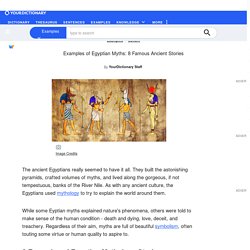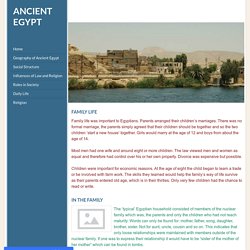

Monsters and Mythical Creatures of Ancient Egypt. In the Egyptian canon, it's often difficult to distinguish monsters and mythical creatures from the gods themselves — for example, how do you classify the cat-headed goddess Bastet, or the jackal-headed god Anubis?

Still, there are some figures that don't quite rise to the level of actual deities, functioning instead as either symbols of power — or ruthlessness — or figures to be invoked as warnings to mischievous children. Below, you'll discover the eight most important monsters and mythical creatures of ancient Egypt, ranging from the crocodile-headed chimera Ammit to the rearing cobra known as Uraeus. Egyptian god. All Egyptian Gods and Goddesses, and Their Places in The Mythology of - Innovato Design. Egyptian Beliefs Egyptians believe in living a life balance and afterlife.

They see the life in ancient Egypt as the best life anyone could live as long as they live by the laws of the Gods. The Gods provide them with everything they need. Egyptians value a peaceful and balanced life. Examples of Egyptian Myths: 8 Famous Ancient Stories. The ancient Egyptians really seemed to have it all.

They built the astonishing pyramids, crafted volumes of myths, and lived along the gorgeous, if not tempestuous, banks of the River Nile. As with any ancient culture, the Egyptians used mythology to try to explain the world around them. While some Eyptian myths explained nature's phenomena, others were told to make sense of the human condition - death and dying, love, deceit, and treachery. Regardless of their aim, myths are full of beautiful symbolism, often touting some virtue or human quality to aspire to.
Top 10 Most Worshiped Ancient Egyptian Gods and Goddesses. Ancient civilization in Egypt contains many facts, some of which still remain a secret, and this great land along the banks of the Nile has featured in both modern and ancient history.

Around 3100 BC, after the political unification of Upper and Lower Egypt, the pharaoh was the supreme leader when it came to rituals and religion. Egyptian deities were considered to represent aspects of nature; the people revered them and did not want to anger them. So what forms did these deities take? Let’s take a look at the top 10 most worshiped gods of ancient Egypt: 1. Egyptian civilization - Myths - Creation myth. Like other creation myths, Egypt's is complex and offers several versions of how the world unfolded.

The ancient Egyptians believed that the basic principles of life, nature and society were determined by the gods at the creation of the world. It all began with the first stirring of the High God in the primeval waters. The creation myth is recounted in the sacred hieroglyphic writings found on pyramids, temples, tombs and sheets of papyrus. These writings describe how the earth was created out of chaos by the god Atum. Games, Sports & Recreation in Ancient Egypt - World History Encyclopedia.
Although the ancient Egyptians are often depicted as death-obsessed and dour, they actually had a great appreciation for life and their culture reflected their belief in existence as an eternal journey imbued with magic.

Inscriptions, artwork, and various objects all make clear that ancient Egyptian life focused on enjoying life and making one's time on earth worthy of living eternally. One of the ways they pursued this goal is familiar to anyone in the modern day: through sports and games. Many of these recreational activities are the same as those in the present day and were played in more or less the same way. Games, Sports & Recreation in Ancient Egypt - World History Encyclopedia. Egyptian civilization - Daily life - Food.
Agriculture Each summer, starting in July, the Nile River rose, flooding the low-lying plains on either side.

Swollen by the monsoon rains of Ethiopia, it deposited a layer of black soil over the land, rich in nutrients needed for growing crops. The river rose about 8 metres (27 feet) on average. If it rose 2.5 metres (8 feet) higher or lower, disaster struck. When it rose too high, villages were flooded, causing extensive damage and loss of life. Ancient Egypt for Kids - Food - Ancient Egypt for Kids.
Pharaoh wanted his people to eat well.

Except for a few sacred animals, there was nothing to stop the people from gathering and growing food. No one went hungry in ancient Egypt. Food was roasted and boiled, and fried and dried, and baked and blended. They had plenty of fresh food to keep them healthy thanks to the Nile River. Family Life and Housing - Ancient Egypt. Family Life Family life was important to Egyptians.

Parents arranged their children’s marriages. There was no formal marriage, the parents simply agreed that their children should be together and so the two children ‘start a new house’ together. Egypt - Gender And Family - Women, Roles, Complementarity, and Society - JRank Articles. Egyptian society is organized on the principle that men and women simply have different natures, talents, and inherent tendencies.

This becomes most apparent in the realm of the family where each gender has a different part to play. Men are created for going out in the world and are responsible for providing financially for the family. Women are suited for remaining within family boundaries, caring for the home, the children, and the husband. Family Life and Housing - Ancient Egypt. Music Ancient Egypt - AskAladdin. Music was an important part of the life of the people in ancient Egypt and musicians during this time were offered a number of prominent positions in society.
Music was very central to the way of life, which can be easily seen from the many texts and illustrations which were found on the monuments in Egypt including temples, palaces, workshops, farms, battlefield remnants and tombs. Music was also very important while performing religious rituals and gods were dedicated specifically to music like Hathor and Bas who were also linked to dance, fertility, and childbirth. Music & Dance in Ancient Egypt - World History Encyclopedia. Music and dance were highly valued in ancient Egyptian culture, but they were more important than is generally thought: they were integral to creation and communion with the gods and, further, were the human response to the gift of life and all the experiences of the human condition. Egyptologist Helen Strudwick notes how, "music was everywhere in Ancient Egypt - at civil or funerary banquets, religious processions, military parades and even at work in the field" (416).
The Egyptians loved music and included scenes of musical performances in tomb paintings and on temple walls, but valued the dance equally and represented its importance as well. The goddess Hathor, who also imbued the world with joy, was associated most closely with music, but initially, it was another deity named Merit (also given as Meret). Musical instruments in ancient Egypt. Music in Ancient Egypt Music played a very important part in ancient Egyptian life. From all periods there are scenes in temples and tombs showing musicians playing. Deities were praised in songs and many women of the elite had titles such as 'chantress of Amun', demonstrating the importance of music in the cults of the gods. The Egyptians did not have musical notations (in contrast to the Sumerians and Greeks).
The sound of the music is therefore lost. Quick Answer: Why Are Egyptian Paintings Sideways? - Ceramics. The goal in ancient Egyptian art was to show the body as completely as possible. This goal served an aesthetic purpose as well as a religious one. Heads were almost always depicted in profile view in two-dimensional art. It is easier to draw a face from the side in order to get the nose correct. Egyptian Art and Mythology. An Introduction Ancient Egypt, the fabled land of the pharaohs, has fascinated many historians and archaeologists. This ancient civilization has a distinctive culture with motifs familiar to most of the western world today, and still captures the imagination more readily than many other cultures of its time. This is largely due to the Egyptian style of art: colorful, consistent, monumental, and mathematical. The pyramids at Giza or the Sphinx are instantly recognized throughout the world, and these works in particular show a constant theme in Egyptian art: the reflection of the culture's metaphysical beliefs and mythology.
Introduction to Ancient Egyptian Art. Egypt - Government and society. BBC - Religions - Islam: Basic articles of faith. Islam: Sunnis and Shiites. Egypt Religions - Demographics. Egyptian civilization - Religion. The Climate Of Egypt. Egypt#:~:text=Southern Egypt's landscape contains low,is completely covered with farms.